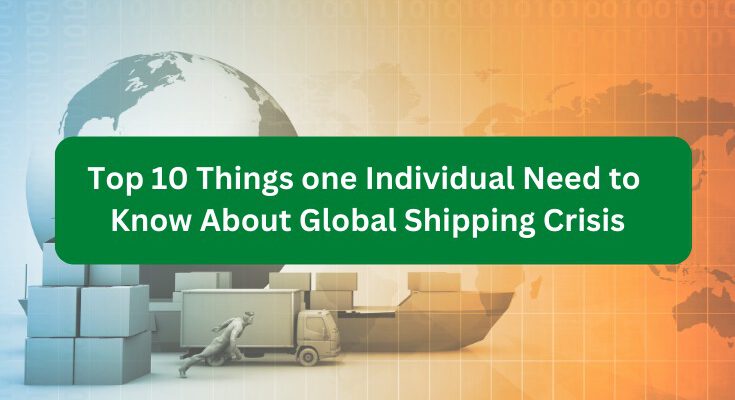International supply networks need to catch up. Natural resources, automobiles, and other items are at or very close to record lows in supply. Consumers will see delays & price hikes that will go through the year-end Christmas season because shipping costs have reached multi-year peaks. The U.S. accounts for a large portion of the market, as consumers appear to be experiencing an unlimited hunger as the economy begins to recover.
The severity of this How did that happen? How does this affect the future? In what way will this affect the international courier services in Mumbai ? And when and where is it resolved?
Let’s begin from the beginning. Be aware that a 90percent of the world’s commerce is transported by sea, and a 70 percent of it is transported in containers. A variety of trends have influenced the company during the last two decades. Early in 2022, there had previously been indications that the disruption in the supply chain was beginning to ease. Still, as geopolitics and other global circumstances change, there are now new dangers and stress points. Among the possible risk elements are:
The First one, the government has been expanding its dependence on imported products and outsourcing in the United States. As far as statistics go, America imported $293 million of commodities from China in January 1985. Fast-forward to August this year, when America imported nearly $43 billion from China. It has increased 146-fold over 36 years. The imports from Asia have grown on the whole. Although China is the leading exporter to the United States, other significant exporters include Vietnam, S. Korea, & Japan.
The most important and second one, more businesses and consumers are placing their orders using just-in-time inventories. Lower inventories result from this, which lowers costs for American companies and gives customers unparalleled access to instant satisfaction from a worldwide abundance of commodities. For example, if Barn wants 50 sofas from China, the corporation places the order, then a couple of weeks later, those couches arrive on the Western Coast of the United States.
In the Third no, there hasn’t been a lot of investment in naval units over the previous ten years due to the shipping industry’s lack of profitability a fricking catastrophe; railroads have already been decreasing expenses and workforce while this has been happening in the U.S.
The Fourth one: The potential for a resurgence of U.S. congestion if Chinese production declines or is connected to the future port worker labour negotiations. So, you have to be aware about it and have manage this thing. This crisis may happen anytime but if you are aware about it then the loss will not be huge.
In the Fifth no: concerns spill over effects from the Russia-Ukraine crisis at ports throughout Northern Europe that were already congested before the conflict. So, this is one of the unexpected crises which no business owner will want to have, but have to be ready for these types of things.
Let’s move to the Sixth no: restrictions on freight movement by air, notably throughout the Asia-Europe region, where flights often pass via Russian airspaces. This thing you will be aware previously, so prepare like that and do the things in your way.
In the Seventh no: Covid-19 shut down in China, notably in Shanghai, wherein decreased production, a lack of truck drivers, and other problems are weakening an already brittle supply chain.
Another important one aka the Eighth one: Delays throughout rail freight, including additional hidden expenses like insurance, in addition to the overland train route between Europe and China being unsure whether goods can travel via Russia.
The Ninth one: Due to their high cost, factories, docks, and transportation capacity are built to operate at high utilization. That implies that they need more room for expansion. However, since manufacturing and distribution operations are at or near capacity, it only takes a little to overload them. It becomes challenging to restore demand and availability to equilibrium since this occurs not only at one stage of the supply chain but in many locations.
The whole supply chain must therefore be evaluated in such cases to identify any bottlenecks & remove them if possible.
Ports might appear to require a quicker unloading process when there is a lengthy line of cargo vessels. However, the ports needed more space for such a large number of container unloading. More lorries are required to carry the products rapidly if storage space for more containers is added.
The final and tenth one: The “bullwhip” effect: Needs distortions
Businesses need to catch up with the rising demand for their goods. As a result, supply networks may experience distortions.
Even if there are only little modifications made at each step of the supply chain, nevertheless cumulative impact of these modifications might give the impression that demand has undergone a significant shift. The bullwhip effect derives its name from the fact that a whip only has a little wrist flick to produce apparent motion. Fixing one bottleneck reveals another.
Ensuring enterprises farther along the supply chain get reliable information about retail demands is challenging. That is, to prevent placing duplicate and excessive orders so that you don’t overcompensate for these interruptions while still constructing the required capacity to satisfy expanding worldwide demand.
Consider all these ten things to know about global shipping crisis: –
The fact that all these shortages won’t last is the most crucial thing to understand. After Christmas, demand will start to decline as businesses expand their capacity.
Recognizing the more significant cessation is necessary for firms to recover from such a supply chain crisis.
One must be upbeat about the potential, notwithstanding the challenges of the supply crisis. For supply chains to weather an event like a pandemic, operational researchers and specialists need to make them more robust. Governments have the chance to reconsider supply chains & strengthen them for clients, businesses, employees, international courier services in Mumbai and individuals everywhere.



